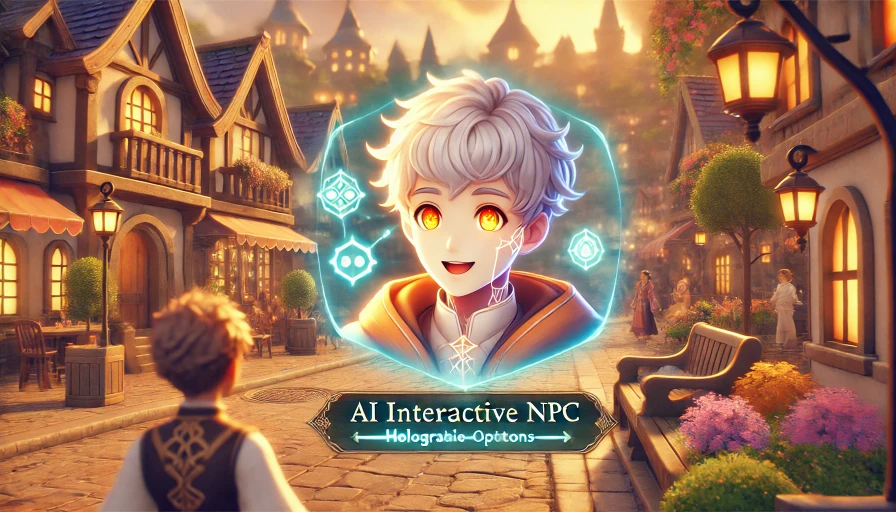Creating Interactive NPCs with Simple AI for RPGs
In RPG worlds, NPCs (Non-Playable Characters) play a crucial role in making the game world feel alive. With simple artificial intelligence, we can create NPCs that interact with players, provide challenges, or even accompany them on their adventures.
Basic Concepts of Interactive NPCs
- State Machine – NPCs have different states, such as idle, talking, attacking, or following the player.
- Dialogue System – A branching dialogue system allows NPCs to respond differently based on player choices.
- Pathfinding – NPCs can move realistically using algorithms like A* or Dijkstra.
- Memory & Behavior – NPCs can remember the player’s actions and react accordingly.
Steps to Create an Interactive NPC
1. Defining the NPC’s Purpose
NPCs can have various roles, such as:
- Merchant who sells items.
- Guide who provides information.
- Companion who assists in battles.
- Enemy who reacts to player attacks.
2. Creating Dynamic Dialogue
Use branching dialogue systems to make interactions more engaging. Example:
{
"npc": "Elder Sage",
"dialogue": {
"greeting": "Welcome, adventurer! What are you looking for?",
"options": {
"quest": "I have a task for you. Do you want to hear it?",
"trade": "I can offer rare items."
}
}
}
3. Adding Simple AI for NPCs
Use condition-based programming to make NPCs more interactive. Example in Python:
class NPC:
def __init__(self, name, position):
self.name = name
self.position = position
def follow_player(self, player_position):
if abs(self.position - player_position) > 1:
self.position += (player_position - self.position) / abs(player_position - self.position)
print(f"{self.name} moves to {self.position}")
npc = NPC("Guard", 0)
player_position = 5
for _ in range(5):
npc.follow_player(player_position)
4. Using Pathfinding for NPC Movement
Algorithms like A* help NPCs navigate open-world environments realistically. In game engines like Unity, this can be implemented using NavMesh or Waypoint Systems.
5. Making NPCs Adaptive
NPCs can respond to player actions using a friendship or morality system. Examples:
- If the player frequently helps the NPC, they will offer rewards.
- If the player attacks the NPC, they will fight back or flee.
Conclusion
Creating interactive NPCs with simple artificial intelligence enhances RPG gameplay by making the world more immersive and challenging. By combining dynamic dialogue, pathfinding, and adaptive behavior, players will feel more engaged in the world they explore.
Choosing Data Server Technology for NPC Integration
To enhance interactive NPCs, a well-structured data server is essential for storing dialogue, behaviors, quest progress, and AI-driven decisions. The right technology ensures smooth integration and real-time responses.
Key Considerations for Data Server Selection
- Performance – The ability to handle multiple NPC interactions simultaneously.
- Scalability – Ensuring the database can grow with new content and AI improvements.
- Latency – Fast response times for real-time interactions.
- Flexibility – Compatibility with different game engines and AI models.
Comparison of Data Storage Options
| Storage Type | Pros | Cons | Use Case |
|---|---|---|---|
| SQL Databases (MySQL, PostgreSQL) | Structured, reliable, supports complex queries | Slower for high-frequency read/write operations | Quest data, NPC behaviors |
| NoSQL Databases (MongoDB, Firebase) | Flexible, fast retrieval, scalable | Less efficient for complex relationships | Dynamic dialogue trees, NPC memory |
| In-Memory Storage (Redis, Memcached) | Extremely fast, ideal for real-time processing | Limited data persistence, high RAM usage | Live AI decision-making, active player interactions |
| Flat Files (JSON, YAML) | Simple, easy to manage, no database setup required | Poor performance with large-scale data | Static NPC data, small-scale RPGs |
Integrating NPC Data with Game Servers
Once the storage technology is chosen, integrating it with the game engine involves:
- Using API endpoints to retrieve and update NPC behavior dynamically.
- Synchronizing player interactions with database updates.
- Caching frequently accessed NPC data for performance optimization.
Example: Using MongoDB for NPC Dialogue
A sample NPC dialogue structure in MongoDB:
{
"npc_id": 101,
"name": "Elder Sage",
"dialogue": [
{"trigger": "greeting", "response": "Welcome, traveler! How can I help you?"},
{"trigger": "quest", "response": "I have a task for you, are you interested?"},
{"trigger": "trade", "response": "I can offer rare items."}
],
"quest_status": "available"
}
Conclusion
Selecting the right data server technology is crucial for optimizing NPC interactions in RPGs. SQL databases provide structured data management, NoSQL enables flexible AI-driven interactions, while in-memory storage ensures real-time responses. The best choice depends on the scale and complexity of the NPC system.


 7:34 PM
7:34 PM








